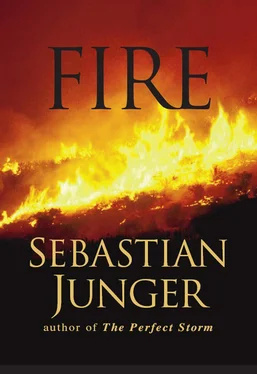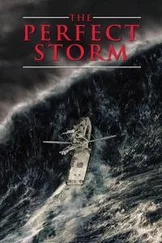The person assigned to me was Bill Casey, a type two safety officer from the Boise area. He was a strong, clear-eyed man in his late forties who directed the local Bureau of Land Management district and was also qualified to command a type two overhead team. (A type two team handles smaller fires, but operates the same way.) He had bagged thirty elk in the past thirty-two years of hunting them, he said. His father hunts with him and can still shoulder fifty pounds of elk meat, at age seventy-one. Casey is part Blackfeet; he has dead-straight gray hair and brown eyes and a handsome, open face.
“We’re a little overstaffed because the fire didn’t do what we expected,” he admitted as we sat in his truck at the helibase.
“What did you expect the fire to do?” I asked.
“Well.” He chose his words carefully. “The guys don’t want to see the forests burn, but on the other hand, they want to have a good, productive summer. They like to have two to three weeks on a fire and then move on to another one. In that sense, it’s disappointing to have the fire lay down so fast.”
We were waiting for our flight into the fire line, and the heater was going full blast in the truck. In the clearing, men were checking the helicopters and writing up flight manifests. The first few days of a fire are usually disorganized to the point of chaos, Casey said. Then it gets better. Casey took advantage of the wait to tell me more about how fires are fought—not from the field but from the office.
“BIFC is just a logistical center that responds to needs in the field,” he said. “Suppose Unit X has a fire. As long as it doesn’t escape the initial attack, BIFC is not involved. If it does escape, then a regional coordination center gets involved. If the regional center doesn’t have enough resources to fight the fire, then BIFC steps in. We’ve had a lot of fires already this summer, and this is the first one where BIFC has been involved.”
Initial attack, he said, comes in many forms. Smoke jumpers are initial attack. Helirappelers are initial attack. Hotshots can be both initial attack and extended attack. Air attack—retardant drops from planes and helicopters—can also be initial or extended. The idea of initial attack is to hit the fire hard and early so that you avoid the expense of an extended campaign. If the attack crews can’t contain it, then an overhead team is assembled and put on the fire. A really big fire will suck in ’shot crews from all over the country. There are a total of sixty nationwide. If that’s not enough, or if they’re needed elsewhere, then type two crews that are trained in fire but often do other work for the Forest Service and BLM are deployed. Farther down in the barrel are convict crews, laborers from the Snake River valley who collect at the center of town when sirens go off, and pickup crews. Pickup crews usually just consist of people with sturdy shoes and in good enough health to pass the training course. When there are pickup crews on a fire, it’s a really bad fire. There were no pickup crews on the Flicker Creek fire.
After about an hour the helicopter was ready. It was a Bell Jet Ranger, rented from a private contractor in Arizona for two thousand dollars an hour. The huge Croman logging ships cost three times that and can sling twenty thousand pounds of retardant in a bucket beneath them. We were read the safety procedures by a helitack crewman and then asked how much we each weighed, with gear. The answers were entered into the flight manifest to calculate how much the helicopter could carry once we were out of the ground effect. Once a helicopter rises about a certain height, the downwash from its rotors no longer has the ground to push against, so it can carry less. If you combine the altitude, the air temperature, and the relative humidity, you have a figure called density altitude that determines how much a helicopter can carry. The retardant buckets, called Bambi buckets or Sims buckets, depending on their manufacturer, could even be cinched down to change the size of the container to compensate for variations in density altitude from day to day.
The crewman went over the instructions again: Keep your head down when you come and go from the helicopter. Never leave a helicopter uphill. Never go toward the rear of the helicopter. Never go anywhere that the pilot can’t see you. If you violate any of these rules, the attendant is authorized to use force to get you to comply.
“I’ll tackle you,” he said.
It was the first flight of the day for this helicopter, so the rotors weren’t turning when we boarded. Gloves on, helmets and goggles on, sleeves rolled down. The attendant made sure we had buckled our seat belts, and then he closed the doors and the rotors heaved into motion.
“By the way, why couldn’t I wear sneakers in the helicopter?” I shouted to Casey.
“Because if we crash, the nylon melts to your skin,” he yelled back.
In front of me, the copilot had a flight helmet that said, “Crashing Sucks.” The technical term for crashing is hard landing. One pilot said that half the pilots he knew had done it. Some had been killed; most hadn’t. Many helicopters these days are designed to autorotate, meaning that they don’t whistle straight downward if the engine fails. They do an awkward imitation of a glide. Most of the Boise National Forest is rocky and steeply angled, though, so it was hard to imagine its turning out well one way or the other.
The Bell Ranger lifted off, and within minutes we had put the camp behind us and I could see smoke coming off a distant ridge. It was not the furious orange blaze I had imagined; it was a 750-acre smudge fire that, if touched by wind or left unattended, could spring to life and go ripping off into the heavy timber north of here. Helicopters were shuttling back and forth from Barber Flats, where they dipped their buckets in a retardant tank. The retardant was rust-colored, and you could see it splotched on the hillsides. Below us, one of the big Cromans was easing down into a steep valley to fill its Bambi bucket in a stream. (Hotshots are fond of saying that fish get scooped up in the bucket and can be found flopping on the hillsides. No one had actually seen this happen, but the story became so widespread that the Fish and Wildlife Service hired a helicopter to see if its pilot could catch fish on purpose. They failed.) The Croman, Casey yelled, carries a bucket that is too big to fit in the retardant tank back at Barber Flats, so it has to use water. It will go back and forth all day between the stream and the fire, directed by ’shot crews with radios. The pilots are so accurate that they can hit individual trees.
We pounded in low along a ridge and then rose and banked and circled and came in again. I could see yellow-shirted hotshots below us, shrouded in smoke. The fire was down in the valley. Several crews were downslope, strung out along the creeping line of black, and several more crews had just landed at the helispot on the ridge and were waiting for orders to proceed. The helicopter made one more approach and then settled down uneasily onto a ridge that plunged steeply away on both sides. The ’shot crews crouched down against the rotor wash, and the helispot attendant, dressed in a green flight suit and hard hat and goggles, flattened himself behind a boulder as if someone were shooting at him. When the aircraft had set itself down but with the rotors still thumping, the attendant scurried forward in a crouch and opened my door and took me out by the arm. Then he returned to get Casey. Occasionally people back up into the tail rotor or walk uphill into the main one, so there is always someone at the helipad to act as an escort. I dragged my pack over behind some bushes and knelt with my head turned away. The helicopter clattered up over our heads and then continued on to shuttle more overhead around the fire.
Читать дальше












